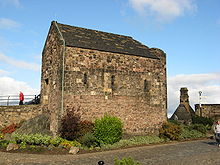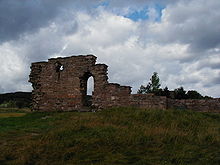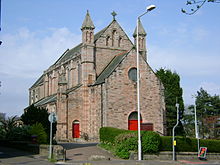- Saint Margaret of Scotland
-
Saint Margaret 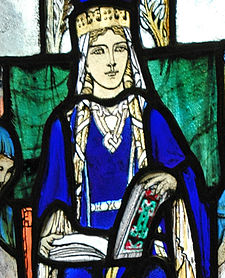
Image of Saint Margaret in a window at St Margaret's Chapel, EdinburghQueen of Scots Born c. 1045
Kingdom of HungaryDied 16 November 1093 (aged c. 48)
Edinburgh Castle, Kingdom of ScotlandHonored in Roman Catholic Church; Anglican Communion Canonized 1250 by Pope Innocent IV Major shrine Dunfermline Abbey Feast 16 November;
10 June (pre-1970 General Roman Calendar)Attributes reading Patronage Dunfermline; Scotland; The Queen's Ferry; Anglo-Scottish relations Saint Margaret of Scotland (c. 1045 – 16 November 1093), also known as Margaret of Wessex and Queen Margaret of Scotland, was an English princess of the House of Wessex. Born in exile in Hungary, she was the sister of Edgar Ætheling, the short-ruling and uncrowned Anglo-Saxon King of England. Margaret and her family returned to England in 1057, but fled to the Kingdom of Scotland following the Norman conquest of England of 1066. Around 1070 Margaret married Malcolm III of Scotland, becoming his Queen consort. She was a pious woman, and among many charitable works she established a ferry across the Firth of Forth for pilgrims travelling to Dunfermline Abbey, which gave the towns of South Queensferry and North Queensferry their names. Margaret was the mother of three Kings of Scotland and a Queen consort of England. According to the Life of Saint Margaret, attributed to Turgot of Durham, she died at Edinburgh Castle in 1093, just days after receiving the news of her husband's death in battle. In 1250 she was canonised by Pope Innocent IV, and her remains were reinterred in a shrine at Dunfermline Abbey. Her relics were dispersed after the Scottish Reformation and subsequently lost.
Contents
Biography
Early life
Margaret was the daughter of the English prince, Edward the Exile and granddaughter of Edmund Ironside, king of England. After the Danish conquest of England in 1016, Canute had the infant Edward exiled to the continent. He was taken first to the court of the Swedish king, Olof Skötkonung, and then to Kiev. As an adult, he travelled to Hungary, where in 1046 he supported Andrew I's successful bid for the throne. The provenance of Margaret's mother, Agatha, is disputed, but Margaret was born in Hungary around 1045. Her brother Edgar the Ætheling and her sister Cristina were also born in Hungary around this time. Margaret grew up in a very religious environment in the Hungarian court. Andrew I of Hungary was known as "Andrew the Catholic" for his extreme aversion to pagans, and great loyalty to Rome, which probably could have induced Margaret to follow a pious life.
Return to England
Still a child, she came to England with the rest of her family when her father, Edward, was recalled in 1057 as a possible successor to her great-uncle, the childless Edward the Confessor. Her father died soon after the family's arrival in England, but Margaret continued to reside at the English court where her brother, Edgar Ætheling, was considered a possible successor to the English throne. When the Confessor died in January 1066, Harold Godwinson was selected as king, Edgar perhaps being considered still too young. After Harold's defeat at the battle of Hastings later that year, Edgar was proclaimed King of England, but when the Normans advanced on London, the Witenagemot presented Edgar to William the Conqueror who took him to Normandy before returning him to England in 1068, when Edgar, Margaret, Cristina and their mother Agatha fled north to Northumbria.
Journey to Scotland
According to tradition, the widowed Agatha decided to leave Northumbria with her children and return to the continent. However, a storm drove their ship north to Scotland, where they sought the protection of King Malcolm III. The spot where they are said to have landed is known today as St. Margaret's Hope, near the village of North Queensferry. Margaret's arrival in Scotland in 1068, after the failed revolt of the Northumbrian earls, has been heavily romanticized, though Symeon of Durham implied that her first meeting with Malcolm III of Scots may not have been until 1070, after William the Conqueror's harrying of the north.
Malcolm was probably a widower, and was no doubt attracted by the prospect of marrying one of the few remaining members of the Anglo-Saxon royal family. The marriage of Malcolm and Margaret took place some time before the end of 1070. Malcolm followed it with several invasions of Northumberland, probably in support of the claims of his brother-in-law Edgar. These, however, had little result beyond the devastation of the province.[1]
Family
Margaret and Malcolm had eight children, six sons and two daughters:
- Edward, killed 1093.
- Edmund of Scotland
- Ethelred, abbot of Dunkeld
- King Edgar of Scotland
- King Alexander I of Scotland
- King David I of Scotland
- Edith of Scotland, also called Matilda, married King Henry I of England
- Mary of Scotland, married Eustace III of Boulogne
Religious life
Margaret's biographer Turgot, Bishop of St. Andrews, credits her with having a civilizing influence on her husband Malcolm by reading him stories from the Bible. She instigated religious reform, striving to make the worship and practices of the Church in Scotland conform to those of Rome. She was considered an exemplar of the "just ruler", and influenced her husband and children, especially her youngest son, later David I, also to be just and holy rulers. She attended to charitable works, serving orphans and the poor every day before she ate, and washing the feet of the poor in imitation of Christ. She rose at midnight every night to attend church services. She invited the Benedictine order to establish a monastery at Dunfermline in Fife and established ferries at Queensferry and North Berwick to assist pilgrims journeying from south of the Forth Estuary to St. Andrews in Fife. A cave on the banks of the Tower Burn in Dunfermline was used by her as a place of devotion and prayer. St Margaret's Cave, now covered beneath a municipal car park, is open to the public.[2]
Death
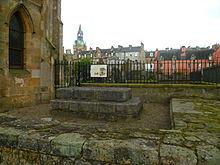 Site of the shrine of St. Margaret, Dunfermline Abbey, Fife
Site of the shrine of St. Margaret, Dunfermline Abbey, Fife
Her husband, Malcolm III, and their eldest son, Edward, were killed in a fight against the English at the Battle of Alnwick on 13 November 1093. Her son Edmund was left with the task of telling his mother of their deaths. Margaret was ill, and she died on 16 November 1093, three days after the deaths of her husband and eldest son.
Veneration
Sainthood
Saint Margaret was canonised in the year 1250 by Pope Innocent IV in recognition of her personal holiness, fidelity to the Church, work for religious reform, and charity. On 19 June 1250, after her canonisation, her remains were moved to Dunfermline Abbey.[3] The Roman Catholic Church formerly marked the feast of Saint Margaret of Scotland on 10 June, because the feast of "Saint Gertrude, Virgin" was already celebrated on 16 November, but in Scotland, she was venerated on 16 November, the day of her death. In the revision of the Roman Catholic calendar of saints in 1969, 16 November became free and the Church transferred her feast day to 16 November.[4] However, some traditionalist Catholics continue to celebrate her feast day on 10 June. She is also venerated as a saint in the Anglican Church.
Churches
Several churches are dedicated to Saint Margaret. One of the oldest is St Margaret's Chapel in Edinburgh Castle, which was founded by her son King David I. The chapel was long thought to have been the oratory of Margaret herself, but is now considered to be a 12th century establishment. The oldest building in Edinburgh, it was restored in the 19th century, and refurbished in the 1990s.
St. Margaret's Church (Margaretakirken) in Maridalen near Oslo, Norway, is dedicated to Saint Margaret of Scotland. The stone church dates from the middle of the 1200s. It is now a ruin, but after restoration in 1934 the church today is one of the best-preserved medieval buildings in Oslo after the Old Aker Church.[5]
Others include the 13th-century Church of St Margaret the Queen in Buxted, East Sussex,[6] and St Margaret of Scotland, Aberdeen.
Other establishments
A number of foundations, particularly in Scotland, are named after Saint Margaret:
- Queen Margaret University, Edinburgh, which adopted the name in 1972
- Queen Margaret College, Glasgow
- Queen Margaret Union, a student union at Glasgow University
- Queen Margaret Hospital, Dunfermline
- The towns of South Queensferry and North Queensferry mark the location of the ferry established by Queen Margaret
- Queen Margaret Academy, Ayr
- St Margaret's Academy, Livingston
- Queen Margaret College, Wellington, New Zealand
- St Margarets School, Bushey
- St. Margaret's Secondary School and Primary School, Singapore
- St Margaret's School, Melbourne, Australia. (Both primary and secondary education.)
http://www.stmargaretssec.moe.edu.sg/ http://www.stmargaretspri.moe.edu.sg/
Citations
- ^ H.E Marshall (1906). "Malcolm Canmore – Saint Margaret came to Scotland". Scotland's Story. http://www.mainlesson.com/display.php?author=marshall&book=scotland&story=margaret. Retrieved 18 March 2011.
- ^ "St Margaret's Cave". VisitScotland. http://guide.visitscotland.com/vs/guide/5,en,SCH1/objectId,SIG49370Svs,curr,GBP,season,at1,selectedEntry,home/home.html. Retrieved 18 March 2011.
- ^ Humphrys, Julian (June 2010). BBC History magazine. Bristol Magazines Ltd. ISSN 1469-8552.
- ^ "Calendarium Romanum" (Libreria Editrice Vaticana, 1969), p. 126
- ^ Margaretakirken (Maridalens Venner)
- ^ Coppin, Paul (2001). 101 Medieval Churches of East Sussex. Seaford: S.B. Publications. p. 130. ISBN 1-85770-238-7.
Further reading
- Chronicle of the Kings of Alba
- Anderson, Marjorie O. (ed.). Kings and Kingship in Early Scotland. 2nd ed. Edinburgh, 1980. 249-53.
- Hudson, B.T. (ed. and tr.). Scottish Historical Review 77 (1998): 129–61.
- Anderson, Alan Orr (tr.). Early Sources of Scottish History: AD 500–1286. Vol. 1. Edinburgh, 1923. Reprinted in 1990 (with corrections).
- Turgot, Vita S. Margaretae (Scotorum) Reginae
- ed. J. Hodgson Hinde, Symeonis Dunelmensis opera et collectanea. Surtees Society 51. 1868. 234-54 (Appendix III).
- tr. William Forbes-Leith, Life of St. Margaret Queen of Scotland by Turgot, Bishop of St Andrews. Edinburgh, 1884. PDF available from the Internet Archive. Third edition published in 1896.
- tr. anon., The life and times of Saint Margaret, Queen and Patroness of Scotland. London, 1890. PDF available from the Internet Archive
- William of Malmesbury, Gesta regum Anglorum
- ed. and tr. R.A.B. Mynors, R.M. Thomson and M. Winterbottom, William of Malmesbury. Gesta Regum Anglorum. The History of the English Kings. OMT. 2 vols: vol 1. Oxford, 1998.
- Orderic Vitalis, Historia Ecclesiastica
- ed. and tr. Marjorie Chibnall, The Ecclesiastical History of Orderic Vitalis. 6 vols. OMT. Oxford, 1968–1980.
- John of Worcester, Chronicle (of Chronicles)
- ed. B. Thorpe, Florentii Wigorniensis monachi chronicon ex chronicis. 2 vols. London, 1848-9
- tr. J. Stevenson, Church Historians of England. 8 vols: vol. 2.1. London, 1855. 171–372.
- John Capgrave, Nova Legenda Angliae
- Acta SS. II, June, 320. London, 1515. 225
- Secondary literature
 This article incorporates text from a publication now in the public domain: Chisholm, Hugh, ed (1911). "St Margaret". Encyclopædia Britannica (11th ed.). Cambridge University Press. http://www.1911encyclopedia.org/St_Margaret.
This article incorporates text from a publication now in the public domain: Chisholm, Hugh, ed (1911). "St Margaret". Encyclopædia Britannica (11th ed.). Cambridge University Press. http://www.1911encyclopedia.org/St_Margaret.- Baker, D. "A nursery of saints: St Margaret of Scotland reconsidered." In Medieval women, ed. D. Baker. SCH. Subsidia 1. 1978.
- Bellesheim, Alphons. History of the Catholic Church in Scotland. Vol 3, tr. Blair. Edinburgh, 1890. 241-63.
- Butler, Alban. Lives of the Saints. 10 June.
- Challoner, Richard. Britannia Sancta, I. London, 1745. 358.
- Dunlop, Eileen, Queen Margaret of Scotland, 2005, NMS Enterprises Limited – Publishing, Edinburgh, 978 1 901663 92 1
- Huneycutt, L.L. "The idea of a perfect princess: the Life of St Margaret in the reign of Matilda II (1100–1118)." Anglo-Norman Studies 12 (1989): 81–97.
- Madan. The Evangelistarium of St. Margaret in Academy. 1887.
- Parsons, John Carmi. Medieval Mothering. 1996.
- Olsen, Ted Kristendommen og kelterne forlaget (2008) Oslo: forlaget Luther (p. 170) ISBN 978-82-531-4564-8 Norwegian
- Skene, W.F. Celtic Scotland. Edinburgh.
- Stanton, Richard. Menology of England and Wales. London, 1887. 544.
- Wilson, A.J. St Margaret, queen of Scotland. 1993.
External links
- University of Pittsburgh: Margaret of Scotland
- Catholic Encyclopedia: St. Margaret of Scotland
- Medieval Women: The Life Of St Margaret, Queen Of Scotland By Turgot, Bishop Of St Andrews Ed. William Forbes-Leith, S.J. Third Edition. Edinburgh: David Douglas, 1896 . Retrieved 14 March 2011.
Preceded by
Ingibiorg FinnsdottirConsort to the King of Scotland
1070–1093Succeeded by
unknown
next known consort:
Sybilla de NormandySaints of Anglo-Saxon England British / Welsh / Irish Alban of St Albans · Aldatus of Oxford · Amphibalus of St Albans · Arilda of Oldbury · Barloc of Norbury · Brannoc of Braunton · Branwalator of Milton · Credan of Bodmin · Congar of Congresbury · Dachuna of Bodmin · Decuman of Watchet · Elfin of Warrington · Ivo of Ramsey · Judoc of Winchester · Juthwara of Sherbourne · Melorius of Amesbury · Nectan of Hartland · Neot of St Neots · Patrick of Glastonbury · Rumon of Tavistock · Samson of Dol · Sativola of Exeter · Urith of Chittlehampton
East Anglian Æthelberht of East Anglia · Æthelburh of Faremoutiers · Æthelflæd of Ramsey · Æthelthryth of Ely · Æthelwine of Lindsey · Athwulf of Thorney · Blitha of Martham · Botwulf of Thorney · Cissa of Crowland · Cuthbald of Peterborough · Eadmund of East Anglia · Eadnoth of Ramsey · Guthlac of Crowland · Herefrith of Thorney · Hiurmine of Blythburgh · Huna of Thorney · Pega of Peakirk · Regenhere of Northampton · Seaxburh of Ely · Tancred of Thorney · Torthred of Thorney · Tova of Thorney · Walstan of Bawburgh · Wihtburh of Ely · Wulfric of Holme
East Saxon Æthelburh of Barking · Hildelith of Barking · Osgyth · Sæbbi of London
Frisian,
Frankish
and Old SaxonBalthild of Romsey · Bertha of Kent · Felix of Dommoc · Grimbald of St Bertin · Monegunda of Watton · Odwulf of Evesham · Wulfram of Grantham
Irish and Scottish Aidan of Lindisfarne · Boisil of Melrose · Echa of Crayke · Ultan the Scribe · Indract of Glastonbury · Maildub of Malmesbury
Kentish Æbbe of Thanet · Æthelberht of Kent · Æthelburh of Kent · Æthelred of Kent · Albinus of Canterbury · Berhtwald of Canterbury · Deusdedit of Canterbury · Eadburh of Thanet · Eanswith of Folkestone · Eormengyth of Thanet · Nothhelm of Canterbury · Sigeburh of Thanet
Mercian Ælfnoth of Stowe · Ælfthryth of Crowland · Æthelberht of Bedford · Æthelmod of Leominster · Æthelred of Mercia · Æthelwine of Coln · Æthelwynn of Sodbury · Beonna of Breedon · Beorhthelm of Stafford · Coenwulf of Mercia · Cotta of Breedon · Credan of Evesham · Cyneburh of Castor · Cyneburh of Gloucester · Kenelm of Winchcombe · Cyneswith of Peterborough · Eadburh of Bicester · Eadburh of Pershore · Eadburh of Southwell · Eadgyth of Aylesbury · Eadweard of Maugersbury · Ealdgyth of Stortford · Earconwald of London · Ecgwine of Evesham · Freomund of Mercia · Frithuric of Breedon · Frithuswith of Oxford · Frithuwold of Chertsey · Hæmma of Leominster · Merefin · Mildburh of Wenlock · Mildgyth · Mildthryth of Thanet · Milred of Worcester · Oda of Canterbury · Oswald of Worcester · Osburh of Coventry · Rumwold of Buckingham · Tibba of Ryhall · Werburh of Chester · Wærstan · Wigstan of Repton · Wulfhild of Barking
Northumbrian Acca of Hexham · Æbbe "the Elder" of Coldingham · Æbbe "the Younger" of Coldingham · Ælfflæd of Whitby · Ælfwald of Northumbria · Æthelburh of Hackness · Æthelgyth of Coldingham · Æthelsige of Ripon · Æthelwold of Farne · Æthelwold of Lindisfarne · Alchhild of Middleham · Alchmund of Hexham · Alchmund of Derby · Balthere of Tyningham · Beda of Jarrow · Bega of Copeland · Benedict Biscop · Bercthun of Beverley · Billfrith of Lindisfarne · Bosa of York · Botwine of Ripon · Ceadda of Lichfield · Cedd of Lichfield · Ceolfrith of Monkwearmouth · Ceolwulf of Northumbria · Cuthbert of Durham · Dryhthelm of Melrose · Eadberht of Lindisfarne · Eadfrith of Leominster · Eadfrith of Lindisfarne · Eadwine of Northumbria · Ealdberht of Ripon · Eanmund · Eardwulf of Northumbria · Eata of Hexham · Ecgberht of Ripon · Eoda · Eosterwine of Monkwearmouth · Hilda of Whitby · Hyglac · Iwig of Wilton · John of Beverley · Osana of Howden · Osthryth of Bardney · Oswald of Northumbria · Oswine of Northumbria · Sicgred of Ripon · Sigfrith of Monkwearmouth · Tatberht of Ripon · Wihtberht of Ripon · Wilfrith of Hexham · Wilfrith II · Wilgisl of Ripon
Roman Augustine of Canterbury · Firmin of North Crawley · Birinus of Dorchester · Blaise · Florentius of Peterborough · Hadrian of Canterbury · Honorius of Canterbury · Justus of Canterbury · Laurence of Canterbury · Mellitus of Canterbury · Paulinus of York · Theodore of Canterbury
South Saxon Cuthflæd of Lyminster · Cuthmann of Steyning · Leofwynn of Bishopstone
West Saxon Æbbe of Abingdon · Ælfgar of Selwood · Ælfgifu of Exeter · Ælfgifu of Shaftesbury · Ælfheah of Canterbury · Ælfheah of Winchester · Æthelflæd of Romsey · Æthelgar of Canterbury · Æthelnoth of Canterbury · Æthelwine of Athelney · Æthelwold of Winchester · Aldhelm of Sherbourne · Benignus of Glastonbury · Beocca of Chertsey · Beorhthelm of Shaftesbury · Beornstan of Winchester · Beornwald of Bampton · Centwine of Wessex · Cuthburh of Wimborn · Cwenburh of Wimborne · Dunstan of Canterbury · Eadburh of Winchester · Eadgar of England · Eadgyth of Polesworth · Eadgyth of Wilton · Eadweard the Confessor · Eadweard the Martyr · Eadwold of Cerne · Earmund of Stoke Fleming · Edor of Chertsey · Evorhilda · Frithestan of Winchester · Hædde of Winchester · Humbert of Stokenham · Hwita of Whitchurch Canonicorum · Mærwynn of Romsey · Margaret of Dunfermline · Swithhun of Winchester · Wulfsige of Sherborne · Wulfthryth of Wilton
Unclear origin Rumbold of Mechelen
Categories:- Scottish royal consorts
- Anglo-Saxon royalty
- Anglo-Saxon saints
- Anglican saints
- Anglo-Saxon women
- House of Dunkeld
- 1040s births
- 1093 deaths
- 11th-century Scottish people
- 11th-century women
- Medieval Scottish saints
- 11th-century Christian female saints
- Burials at Dunfermline Abbey
Wikimedia Foundation. 2010.

